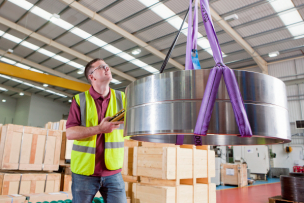Find the gloves that are right for your workplace.
It’s hard to imagine a job that doesn’t require your hands. Yet as valuable and versatile as these tools may be, they’re also vulnerable. U.S. workers sustain well over 1 million hand injuries per year, according to the National Safety Council. In fact, cuts, punctures, fractures, burns and other harm to the hands account for about 1 in 5 disabling mishaps on the job.
Equipping machines and tools with hand guards and other safety features helps prevent these injuries, but providing your associates with appropriate gloves, finger guards and arm coverings is essential, too. That’s not just good workplace practice—it’s required by the Occupational Safety and Health Administration (OSHA), which mandates that employers supply adequate hand and arm protection as part of an overall ensemble of personal protective equipment (PPE).
Getting a solid grasp on how your associates protect their hands can keep them safe and prevent downtime, productivity loss and a boost in insurance costs. As part of a routine PPE assessment, collect the following information about your associates’ gloves and how they use them:
Are all associates who require hand protection using it?
Workers who forget their gloves in a locker or utility truck will often risk injury by tackling a task barehanded, says Frank Quarato, president of the Center for Safety & Environmental Management, which conducts safety training and education programs for a wide range of businesses. Ensuring that gloves are always accessible (such as attaching them to work belts with rings) can increase compliance.
Are your associates’ gloves keeping up with modern advancements?
Manufacturing has undergone sweeping changes in recent years, yet hand protection hasn’t kept pace at many worksites, says Jamie Ashworth, senior director of North American marketing for the glove maker Ansell. For example, the thinner-gauge sheet metals many manufacturers now use are cost-effective but produce sharper edges, requiring workers to use gloves with greater cut resistance than was adequate in the past. Moreover, working with thinner metals demands greater dexterity. Aramid (such as Kevlar) gloves that have steel or fiberglass incorporated into the fibers provide great cut protection, while coatings such as nitrile and neoprene improve grip, says Ashworth.
Do your hand gloves match your associates’ needs?
Mismatching gloves to the task is a common problem. “We see this all the time in the chemical industry,” says Ashworth. For instance, workers may use expensive, heavy gloves that provide hours of permeation protection—which guards against chemicals seeping through to the skin—for jobs that require only a few minutes of exposure to harsh chemicals. “That means you’re not getting a good cost-to-use ratio,” says Ashworth. Meanwhile, prolonged exposure to relatively innocuous-seeming chemicals such as acetone or isopropyl alcohol can degrade commonly used nitrile gloves, potentially harming the skin. (In many such cases, neoprene gloves are a better choice.)
Ensuring that your associates are following proper “donning and doffing” and decontamination procedures for their gloves is vital, too.
Check the Standard and Reports
Still not sure which gloves your associates need? The American National Standards Institute publishes a report that rates gloves by the level of protection they provide for a given task on a scale of 0 (none) to 6 (highest). The key, says Quarato, “is having the right glove in the right place.”
What gloves are your associates using, and are they right for the job?


Talk to Us!
Leave a reply
Your email address will not be published. Required fields are marked *